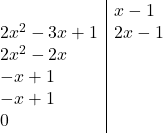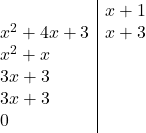Sometimes, quadratic equations can be solved by factorizing, which is also called grouping. The solve by factoring process is usually consists of three major steps:
All terms should be moved to one side of the equation using addition or subtraction. Rewrite the equation so that the left side of the equation is set equal to 0. For example, if the original equation is  , it should be rewritten as
, it should be rewritten as  .
.
The equation should be factored completely. It will have two factors.
Each factor should be set equal to zero. Since factors are of first power, they are easy to be solved.
All of the solutions should be combined to obtain the full solution set for the original equation.
The catch of this method is the finding of factors. Except some trivial cases, factoring quadratic equations is not easier than using other methods to solve the quadratic equations. Here are a few tips to help you factorize a quadratic equations:
1) Use polynomial identities:
Example 1:
Solve the quadratic equation  .
.
Comparing with  , we see that substituting
, we see that substituting  and
and  we have,
we have,
Example 2:
Solve the quadratic equation  .
.
To use the identity  we need to find
we need to find  and
and  such that their summation is
such that their summation is  and multiplication equals to latex
and multiplication equals to latex  . It is not that hard to “guess” that
. It is not that hard to “guess” that  and
and  satisfy the condition. Therefore,
satisfy the condition. Therefore,
Example 3:
Solve the quadratic equation 
Assuming  and
and  , the identity
, the identity  can be used to factor this equation. We have,
can be used to factor this equation. We have,
2) Guess one of the factors:
If coefficients are integer, it is sometimes easy to guess one of the factors.
Example 4: Solve the quadratic equation 
Since  satisfies the equation,
satisfies the equation,  is one of the factors. We can divide the equation by
is one of the factors. We can divide the equation by  to find the other factor:
to find the other factor:

Therefore, the other factor is  and the original has two answers
and the original has two answers  and
and  .
.
Example 5: Solve the quadratic equation 

Thus, the other factor is  and
and  is the other answer. Therefore, the original has two answers
is the other answer. Therefore, the original has two answers  and
and  .
.
As explained, factoring quadratic equations does not have a straight-forward procedure to follow. Therefore, the usage of this method is restricted to some trivial equations and relies mostly on your skills. You can learn about other methods of solving quadratic equations here.
Leave a Reply